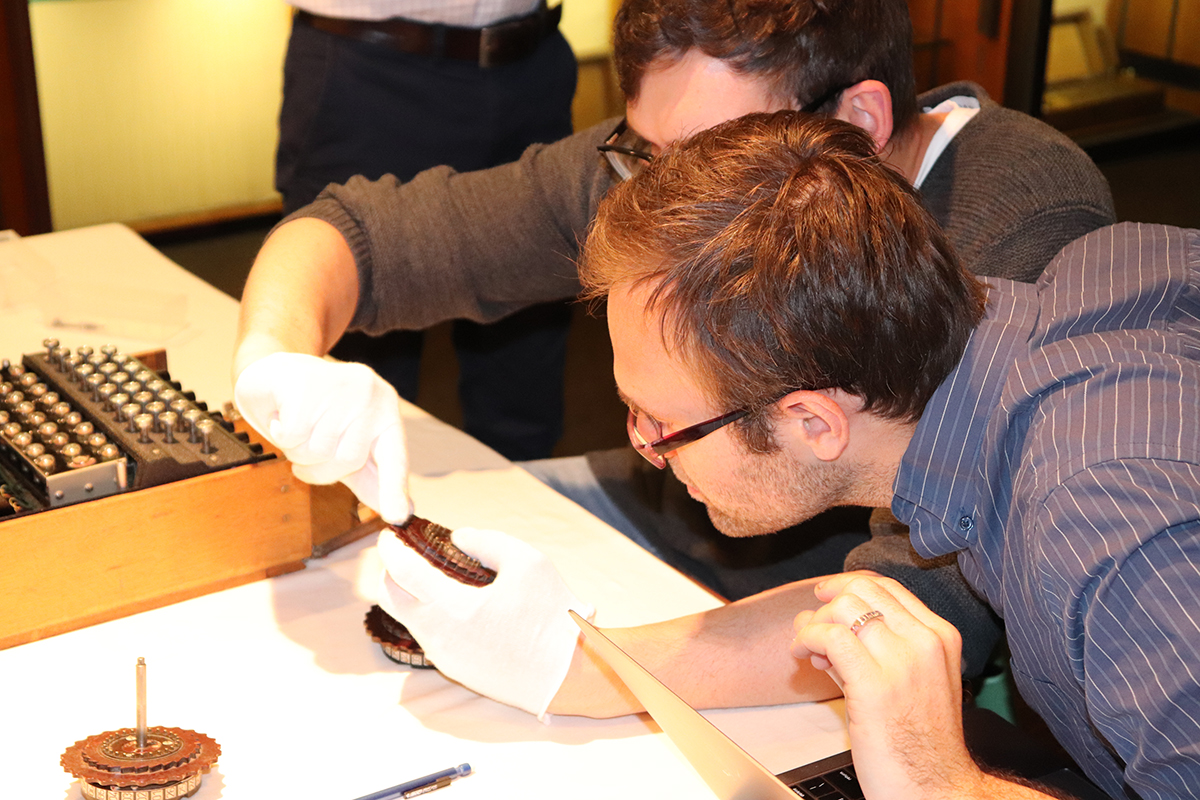HCII Researchers Go Inside the Enigma
Shannon RiffeMonday, October 14, 2019Print this page.

Researchers had a rare opportunity to peek under the hood of the Carnegie Mellon University Libraries' two Enigma machines, opening the World War II-era machines to photograph their carefully crafted interiors and locate and record the serial numbers printed on their rotors.
The University Libraries acquired the two encryption devices — one four-rotor machine and one three-rotor machine — in February 2018 as part of a collection of more than 50 calculating machines, letters and books gifted to the university by author Pamela McCorduck, wife of the late Computer Science Department Head Joseph Traub. With this gift, CMU became one of a handful of American institutions to own an Enigma machine.
Enigma machines, electromechanical rotor cipher machines used to encrypt communication, were most notably used by Nazi Germany to protect military communication during World War II.
During a four-hour period on Oct. 7, campus historians and researchers associated with History of Science and Technology at CMU (HOST @ CMU) — a cross-campus, interdisciplinary initiative to collect and preserve CMU's historical contributions to scientific and technical development — assembled in the Hunt Library Fine and Rare Book Room to open the machines.
Andrew Meade McGee, visiting assistant professor of history and the University Libraries' CLIR Postdoctoral Fellow in the History of Science and Computing, described the procedure as a hands-on history exercise.
"Today, historians and engineers with screwdrivers are attempting to recapture the inner workings of a past technology and trace the intellectual connections between this electromechanical piece of the past and today's information technology ecosystem," McGee said.
Under the direction of Chris Harrison, Haberman Chair and assistant professor of human-computer interaction, three researchers partially disassembled the intricate machines. With only 318 Enigma machines known to exist today, the experience offered a once-in-a-lifetime opportunity for the Human-Computer Interaction Institute's Sven Mayer, a postdoctoral researcher, and doctoral students Yang Zhang and Karan Ahuja.
"This is a really exciting opportunity to have a piece of computing history, to be a part of its history and to find out more about its history," said Harrison, who leads the HCII's Future Interfaces Group.
When the university received the Enigma machines, their model type, creation year and the unit they may have been assigned to during WWII were unknown.
"Part of our investigation today is to check out the condition of the machines to see what quality they've survived in and to recover the serial numbers on the rotors in particular, which are a major clue to identifying when it was made, where it was made and the configuration it was in," Harrison said.
Wearing white cotton gloves, Mayer and Ahuja carefully dismantled the three-rotor machine first, pausing occasionally to consult with Harrison or refer to online resources. As they removed the rotors, they elicited cheers from the small assembled crowd, which included Mary Kay Johnsen, special collections librarian, and Scott Weingart, program director, Digital Humanities.
Mayer, a German speaker, translated inscriptions found inside the case.
"The inscription was like a manual with a description of how to use and maintain the machine, and inside there was a description of how to put new lamps in," Mayer said. "There was no useful information to disassemble the machine."
In addition to serial numbers, the researchers inspected the construction of the boxes and internal mechanisms, the arrangement of keys, and details on the plugboards, which allowed them to identify the models as an Enigma 3-Rotor A5005 and Enigma 4-Rotor M16681. Manufacturer marks revealed through the disassembly suggested the factories of origin.
The presence of an "A" at the beginning of the serial numbers on rotors of the three-rotor Enigma machine indicated that it was used by the German Army or Air Force. The four-rotor machine, however, appeared in such pristine condition that Harrison doubted that it had ever been used in the field.
Despite the clues unearthed during the disassembly, questions remain.
"While we found one of the machines on a list of all known machines in the world, the other appears to have been previously undocumented," Harrison said. "The next steps will be some basic preservation and maintenance, and then reaching out to experts who can hopefully shed more light on the provenance."
Byron Spice | 412-268-9068 | bspice@cs.cmu.edu<br>Virginia Alvino Young | 412-268-8356 | vay@cmu.edu
